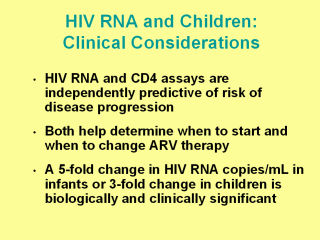| front |1 |2 |3 |4 |5 |6 |7 |8 |9 |10 |11 |12 |13 |14 |15 |16 |17 |18 |19 |20 |21 |22 |23 |24 |25 |26 |27 |28 |29 |review |
 |
Viral burden in peripheral blood can be
determined by using quantitative HIV RNA assays. During the period of
primary infection in adults, HIV RNA copy number initially rises to high
peak levels. Coincident with the body's humoral and cell-mediated immune
response, RNA levels decline by as much as 2–3 log10
copies to reach a stable lower level (i.e., the virologic setpoint)
approximately six to twelve months following acute infection, reflecting the
balance between ongoing viral production and immune elimination (31, 32).
Several studies conducted among adults have indicated that infected persons
with lower HIV copy number at the time of RNA stabilization have slower
progression and improved survival compared with those with high HIV RNA set
points (33, 34). On the basis of such data, recommendations for the use of HIV RNA copy number in deciding to initiate and change antiretroviral therapy in infected adults have been developed (5). These recommendations also are applicable to infected adolescents, particularly those who have acquired HIV infection recently rather than through perinatal infection. Inherent biologic variability must be considered when interpreting changes in RNA copy number in children. Thus, only changes greater than five fold (0.7 log10) in infants aged <2 years and greater than three fold (0.5 log10) in children aged 2 years after repeated testing should be viewed as reflecting a biologically and clinically significant change. |